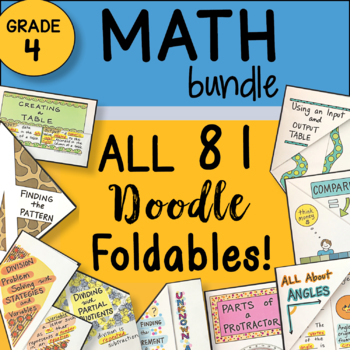4th Grade Math Interactive Notebook Doodle Foldables - ALL the Foldables Bundle
- Zip
What educators are saying
Description
Creative and Engaging 4th Grade Math Foldables that are grade specific for just Fourth Grade. Aligned to the TEKS and Common Core. So many topics and every concept explained in step by step directions with examples. 81 Original and Unique Foldables!
Raise test scores with so many creative foldables that engage the students and teach the concepts. Students love these! I sell individual foldables for $3 each so this is seriously a smokin' hot deal!
Do Not Double buy - these foldables are also found in the ALL YEAR SET click: ALL YEAR SET for 4th Grade
If you just want the foldables this is a great deal - if you want it ALL then get the All Year SET.
Foldable Names
1. Place Value Chart
2. The Base 10 System
3. All About Numbers
4. Compare and Order
5. Place Value for Decimals
6. Comparing Decimals
7. Comparing Decimals on a Number line
8. Rounding Whole Numbers
9. Adding & Subtracting Whole Numbers
10. The Basics of Adding & Subtracting Decimals
11. Adding Decimals
12. Subtracting Decimals
13. Estimation with Whole Numbers
14. Problem Solving for Addition & Subtraction
15. Multiplying Tens & Hundreds
16. Multiplying 2 Digit Numbers with Arrays
17. Multiplying 2 Digit Numbers with Area Models
18. Multiplying 2 Digit Numbers with Equations
19. Mental Math
20. Multiplication Properties
21. Distributive Properties of Multiplication
22. Strategies for 2 Digit Multiplication
23. 2 Step Multiplication Using Algorithms
24. Problem Solving with Multiplication
25. Zero the Hero
26. Multiplication Facts
27. Lines, Points + Rays Oh My!
28. Basic Geometric Ideas
29. Lines of Symmetry
30. Intro to Angles
31. Classifying 2-Dimensional Figures
32. Understanding 2-Dimentional Figures
33. Classifying Triangles
34. All About Angles
35. Parts of a Protractor
36. How to Use a Protractor
37. Drawing Angles with a Protractor
38. Finding the Measurement of Unknown Angles
39. Dividing with Models
40. Dividing with Partial Quotients
41. Dividing Using the Standard Algorithm
42. Zeros in the Quotient
43. Dividing with Remainders
44. Division Problem Solving
45. Zero the Hero
46. QDPAC
47. Review of Strip Diagrams
48. Two Step Problem Solving Part 1
49. Two Step Problem Solving Part 2
50. Finding the Pattern
51. Creating a Table
52. Using an Input/Output Table
53. All About Measurement
54. Tools for Measurement
55. The Customary Measurement System
56. The Metric Measurement System
57. Converting Customary Units of Measurement
58. Converting Metric Units of Measurement
59. Converting Units
60. All About Perimeter
61. All About Area
62. Area and Perimeter
63. Finding the Missing Piece
64. Problem Solving with Area & Perimeter
65. Writing and Recognizing Fractions
66. Decomposing Fractions
67. Equivalent Fractions
68. Comparing Fractions
69. Adding & Subtracting Fractions with Models and the Number Line
70. Adding & Subtracting Fractions with Like Denominators
71. Relating Fractions to Decimals
72. Benchmark Fractions
73. Tables and Dot Plots
74. Stem and Leaf Plots
75. Looking at Data in Different Ways
76. Problem Solving with Data
77. Fixed and Variable Expenses
78. All About Profit
79. Advantages and Disadvantages of Saving Options
80. Budgeting and Allowance
81. Financial Institutions
TEKS and Common Core Aligned!


